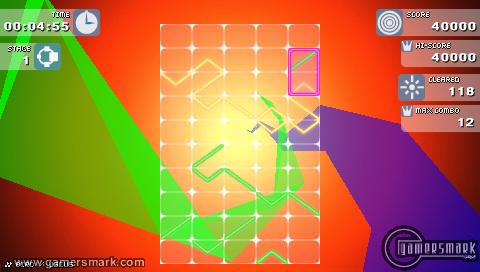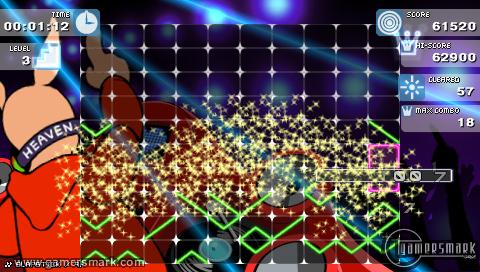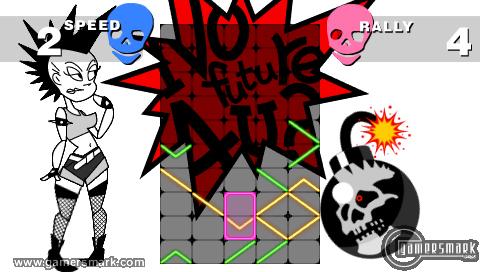Developer: Q Entertainment / Publisher: Namco Bandai Games || Overall: 8.5/10
Q Entertainment kindled a puzzle-loving flame that was deep inside me. For some reason, combining puzzle action with electronic music made me a puzzle fan in short manner after years of being very impartial towards them. After getting my fill of Lumines and Lumines II, something new needed to fill up the large gaps in my life with no puzzle game to play. That’s where Gunpey stepped in. Based on Gunpei Yokoi’s original Gunpey on the WonderSwan, Q has taken the liberty of enhancing the formula to integrate its crazy backgrounds and electronic music that is seemingly trademark of the company’s puzzle games.
The basic concept of Gunpey is quite simple. The goal is to clear lines that appear on the grid by connecting them from the left side of the grid to the right side. Pieces at the bottom of the screen randomly appear at varying speeds and quantities that can and will throw kinks into your plans of obtaining all forty skins that are included in the game. You’re not restricted to just making lines, however. From the four different lines that make up the Gunpey puzzle, you can create shapes, long zig-zagging lines, and anything else that you can think of.
While the concept of Gunpey is simple enough, the actual difficulty can go from a breeze to a hurricane in a matter of minutes. The main game’s Challenge mode progresses by changing skins – a combination of background and music – and by digression, unlocking the skins you play through. The ever-present goal that is presented in Challenge mode is to unlock all the skins and beat your previous high scores. Skins in Challenge mode have a very untraditional progression as far as difficulty goes. The first three skins are very easy to complete, but after a predetermined amount of skins, you’ll always hit a really obscurely hard skin that will kick your ass if you don’t pay enough attention to what’s happening on the grid. After you get through a “hard” skin, the game will slow down again, as if it’s giving you a rest from what just happened. This pattern of progression is similar to what happens throughout the game, except the little “breaks” you might have are very relative according to which level you’re on. This game is merciless when it comes down to it. If you don’t keep on your toes, a line you didn’t see could pass into the top squares and before you know it, you lose all your progress. It is very disconcerting when you’re eighteen skins in, and all of a sudden lose, knowing that you’re barely even halfway through while questioning your ability.
While Challenge mode is the “main” game, Gunpey offers many different types of modes that will keep the game’s formula fresh and challenging for quite a while. There are modes to play with two skins at the same time, an oversized Gunpey grid, and Ad Hoc multiplayer. The selection of different spins on Gunpey is a very nice addition to break up the frustration of Challenge mode.
While Gunpey is a very well put together title, there are a few grievances that affect the overall sentiment. For one, skins take way too long to complete. Compared to Lumines and Lumines II, Gunpey’s skins take at least twice as long to complete, typically around five minutes. It can be quite nerve-racking if you’re trying to power through and experience all the skins, which I’m still not able to do. Another annoying aspect is the absence of any option of auto-saving. Being a major proponent of auto-saving, I found it quite unfortunate that a game like Gunpey does not have it. A somewhat interesting, and very annoying, design choice occurs after you complete a line. If you’re moving a piece just as a line disappears, the game will stop responding to any of your button pushes for a small increment of time. When it comes to a fast-thinking game like Gunpey, it is a big oversight and needless restriction. Unless that’s part of the game’s intentional difficulty, which it doesn’t feel like, it’s just plain annoying.
Gunpey is definitely not the most complex puzzle game I’ve experienced, but it is certainly a great addition to the PSP’s library when all is said and done. Gunpey is another example of how well the PSP plays puzzle games, especially ones that are audio and visual-intensive. I can only hope that Q Entertainment keeps rolling with more unique puzzlers like Gunpey.



